The Primary Arms SLx 2.5 Compact 2.5×32 Prism Scope has been my go-to optic for a few years now. They have done a phenomenal job of combining practicality, reliability, and price for a general-purpose optic. From the Primary Arms website, they retail for $250 but you can often find deals on them from many distributors, including their own site. That is a hard price to beat even before the sale. You’ll have to excuse the beat-up nature of the optic I’m showing here. It has been through a lot, but with that comes confidence in its use and the information I’m passing on to you.

Check Price at:
Features
- Magnification – 2.5x
- Reticle – ACSS CQB-M
- Mounting – 1913 Picatinny Rail or Bolt on to carry handle
- Illuminator – 11 settings / Red
- Adjustments – Windage and Elevation ½ MOA clicks
- Eye Adjustments – Focal Ring
- Objective threading for honeycomb reflection eliminator
- Battery Type – CR2032 Lithium Coin
- Eye Relief – 2.7in
- Field of view at 100 yards – 37.5 Feet
- Mount on top for a red dot
Reticle
If you have never used a reticle beyond a plain duplex or a red dot, the ACSS-CQB-M1 reticle can seem a little intimidating at first. Once you understand that everything in the reticle serves a purpose and you learn what each piece of it does though, you realize it is a very simple and effective reticle.
It is geared more towards fighting than just a target shooting or hunting reticle though it can still be used for both of those. The bullet drop compensator (BDC) has recommended zero ranges based on the cartridge you are shooting and for me, that is 5.56.
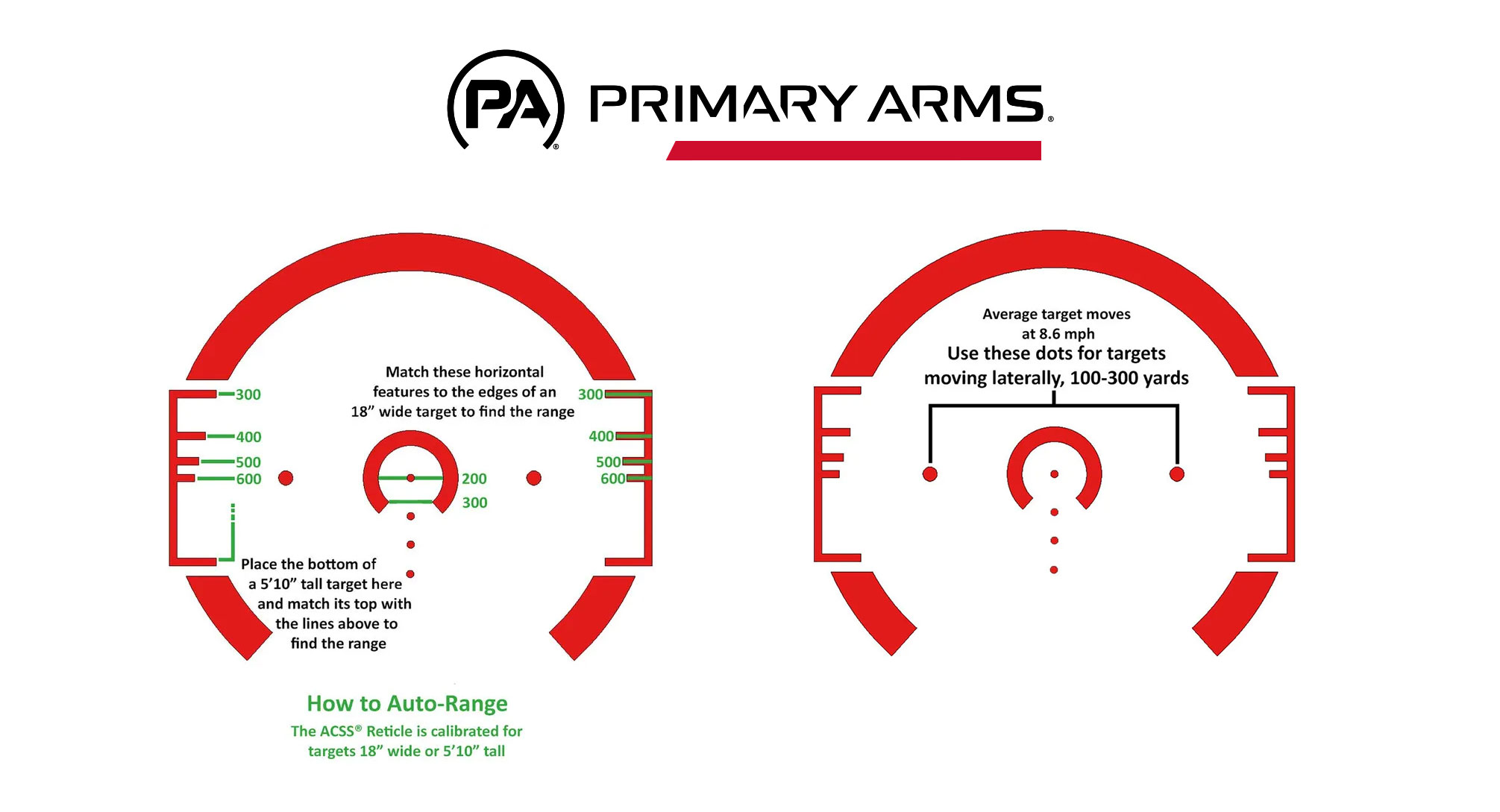
The center small dot should be zeroed at 50 meters which also doubles as your 300-meter aiming point. Each dot below that corresponds to an additional 100 meters in distance. The second dot is a 400-meter hold, the third a 500-meter hold, and the fourth dot is your 600-meter hold. It is important to understand that this is a general aiming point and will not be a perfect match at each distance. Without getting into a thorough explanation of ballistics, variations in ammo manufacturers, bullet weights, muzzle velocities, barrel length, and the environment are going to play a role in where exactly your bullet is going to impact. You need to get out and confirm the impact locations for each dot and memorize them.
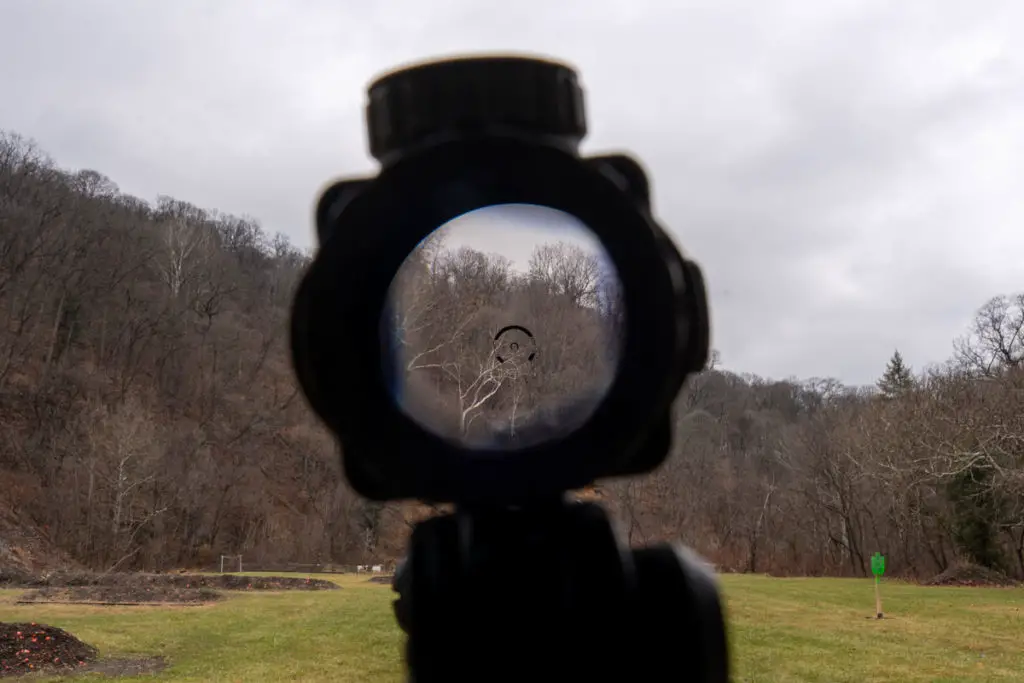
The smaller horseshoe that wraps the top dot of the BDC serves two purposes:
- It is a quick-ranging tool
- It allows for quick “snapshots” out to 100 meters.
If you line up the center dot with your target and its shoulder width fits flush inside the widest point of the smaller horseshoe, the target is approximately 200 meters away. If the target’s shoulders fit flush in the gap at the bottom of the smaller horseshoe the target is approximately 300 meters away. This ranging is based on the target being 18 inches wide which is close to the average width of an adult male’s shoulders.
It also doubles as a quick point of aim for targets inside 100 meters. If a target presents itself and you need to engage as rapidly as possible you don’t have to worry about looking for a small precise point of aim. You center the smaller horseshoe around the target and squeeze the trigger. It isn’t precise but it’s close enough when time isn’t an option.
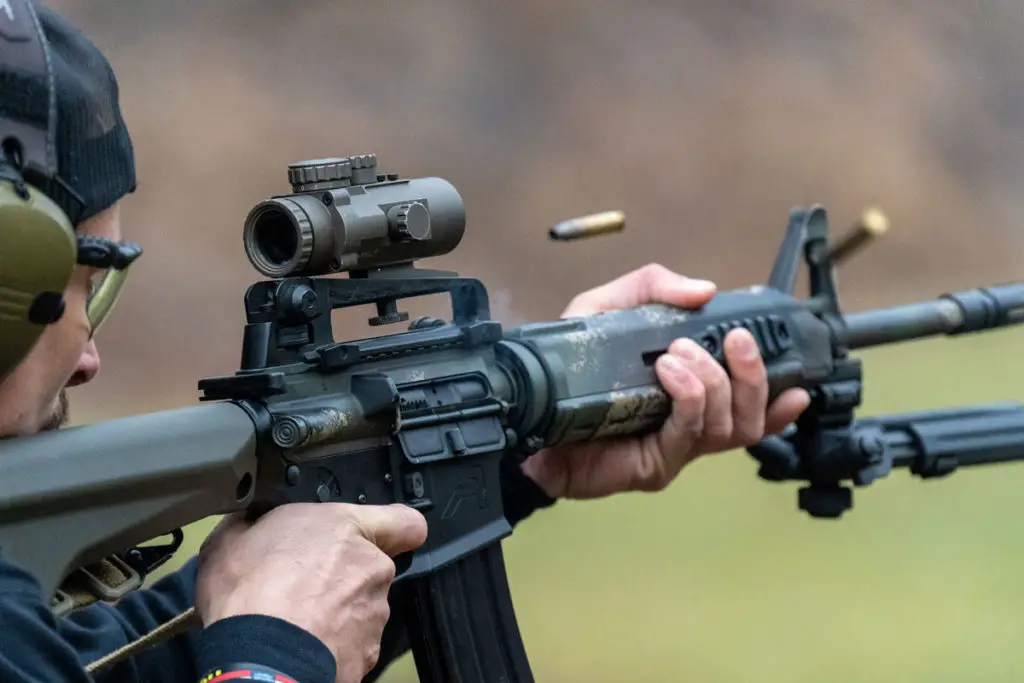
Continuing to move outward, there are two small dots to the left and right of the center horseshoe that are points of aim for moving targets. They are calibrated to hit a target moving 8.6 mph which is close to the average run speed of an adult male. Like the BDC, this is a general reference point and there will be variations in impact depending on bullet velocity, time of flight (distance to the target), the angle the target is moving, and speed of the target. Also, don’t confuse this with being a compensator for wind speed. An 8.6 mph wind will not deviate the bullet away from the target the same as a target moving at 8.6mph.
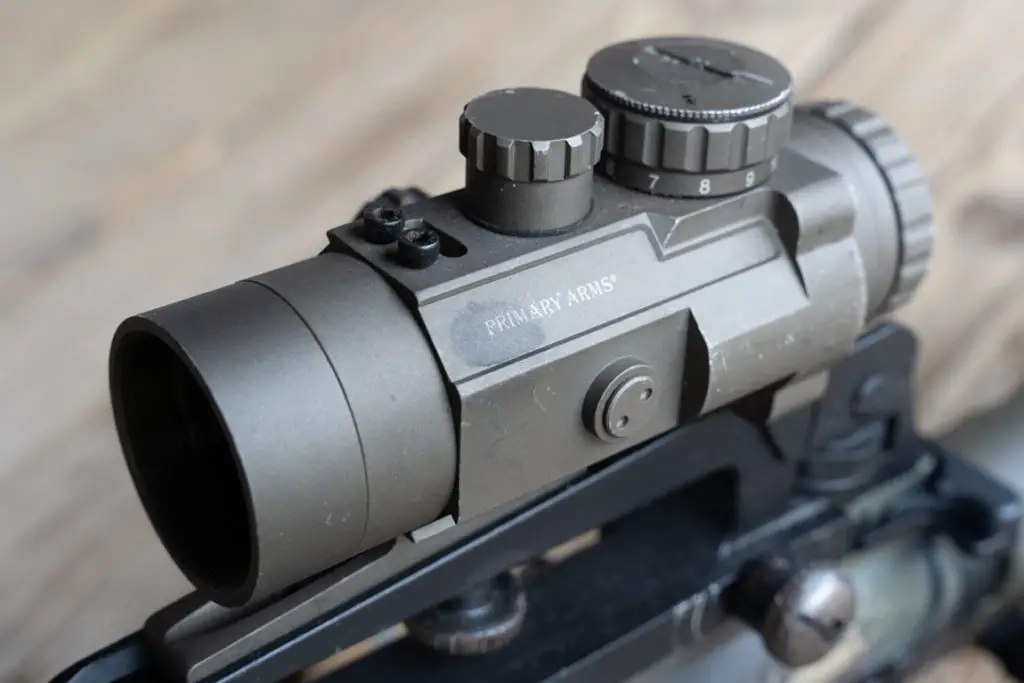
Moving to the outer ring in the reticle, there is a ranging ladder on both sides. Like the smaller horseshoe in the center, this is a tool for estimating the range of a target. This range estimation tool works by placing the bottom rung of the ladder at the base of a target and determining where the top of the target ends within the ladder. The calibration is based on a 5’10 target, which is the average height of an adult male. The rung at which the top of the target ends determines its distance. The top rung is 300 meters, the next down is 400 meters followed by 500 then 600 meters at the bottom. If it lands in between the rungs, do your best to estimate the difference. If a full standing profile isn’t an option for ranging, the rungs also serve as a horizontal measurement. Place the rungs across the shoulders (just like the smaller horseshoe) and if the shoulders fit flush with the rungs, the target is at the corresponding distance. Distances are the same as the vertical measurement with the top rung being 300 meters and so on.
The last part of the reticle is the outer horseshoe which serves as a quick reference aiming point for close-quarters engagement. No perfect sight picture or alignment is necessary (though preferred). Throw the reticle around the shoulders of a target with a quick snapshot and squeeze the trigger and you’ll generally get a center mass hit.
Do you see why it’s geared more toward a fighting rifle now? Once you learn how everything interacts with each other in the reticle, you see how effective it can be.
Mounting

Probably my favorite part about these optics is their mounting options. There are two ways you can mount it:
- M1913 picatinny mount with bolts that tighten via crescent or socket wrench
- Single bolt mount into an AR15 carry handle
The standard picatinny mount is straightforward. It is just two bolts with screws that mount through the slots in the rail. Having two bolts spread allows for better tension distribution on the mounting plate. Instead of pinpointing the pressure on the center of the plate, you can get an even bite across the entire base by alternating the torque on each screw until they are both mounted to spec.
While the standard base plate offers a reliable mounting option, I am personally inclined to use the carry handle mount option. This requires the purchase of a separate screw but it is only $5 on their website. The baseplate is able to be removed from the optic itself leaving the slender column on the bottom of the optic. This column has the mounting point for the screw in the center of it. You simply place the optic in the slot of the carry handle and line up the thread with the hole and insert the screw. I highly recommend you use a thread locker for this screw. The first time I mounted it without the locker and after a few hundred rounds it started to back itself out. Once I put a thread locker on it though I have not had it happen again post thousands of rounds.

Now for what I love about this mounting option:
- It gives it a natural rise that you’d otherwise be spending a lot of money on for an aftermarket optic riser.
- It has a tunnel cut through the column where it mounts that allows you to still use your iron sights.
- It is so aesthetically pleasing.
Personally, I am a fan of carry handle setups and to find a magnified optic with a sleek low profile mounting option that still allows me to use the natural iron sights without any extra modifications is a big deal. Aside from looking really cool, having access to your irons by simply dropping your head an inch is on point. One of the downsides to any optic with glass is its susceptibility to being obscured by adverse environmental conditions.

Whether it is a $250 or a $2500 piece of glass, mud, fog, water, snow, and debris is going to prevent you from using it. The quick access to irons gives you the option to aim in a pinch if you are unable to immediately get your glass clean. I’ve used this option a couple of times when competing in adverse weather where not only my optic was smeared to the point I could not see through it, but everything on me was so dirty and wet that trying to clean the optic off only made it worse.
Reliability
The PAC2.5x optic is made with a hard-anodized, single-piece 6061-T6 lightweight aluminum alloy body. The caps for the windage and elevation adjustment dials, the reticle illumination dial, and the battery seat cap are also made of the same material. The Primary Arms SLx 2.5 Compact PAC2.5x prism sight is completely fog proof, waterproof, and nitrogen-purged to resist the elements.
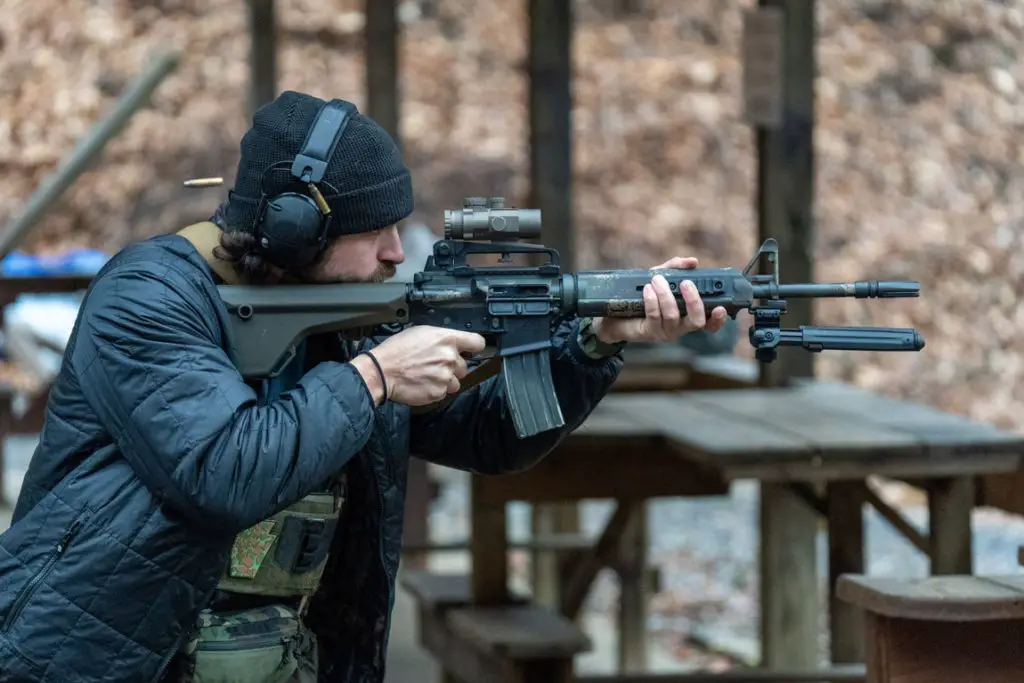
After years of heavy use, my personal PAC2.5x is still as functional as the day I got it. It’s taken a lot of hard falls and jars from being bounced around in the back of vehicles to me slipping and falling on it in the woods and on rocks. Despite the beatings, the glass is still clear and it holds its zero. The adjustment turrets still track well and the mount is solid. The casing for the optic has a lot of wear and tear, but it’s all purely cosmetic and just a natural occurrence with lots of hard use.
If it can survive use by my clumsy self moving it through rough terrain, it will survive just about anything you can throw at it… except for bombs. Nothing is really bombproof if the bombs are big enough.

Application
The application of this optic totally depends on the user’s desired intent. As I mentioned earlier, based on the reticle design, it’s designed as a “combat” optic, but that doesn’t mean it can’t be used for other applications. For hunters, if your prey’s average size matches close to the ranging tools in the reticle, you can estimate its range just like on a person.

The bullet drop compensator can be applied to any shooting at distance. The laws of physics don’t care if you’re in a fight, hunting an animal, shooting competitively, or casually plinking with your boys, having a means to adjust your point of aim to compensate for bullet drop will be necessary for accurate shot placement.
It is a fast optic for being magnified. The horseshoes in the reticle, especially when illuminated, really help with the rapid acquisition of targets at close range. Is it as fast as a dedicated red dot? …almost. With enough practice, I am almost as fast with the PAC2.5x as I am with a red dot within 25 meters. If you want a red dot though, you can have that too by mounting it on top.
There are options out there that can provide a similar setup like a red dot and magnifier combo, but that comes with two problems you won’t get with the PAC2.5x:
- It’s going to cost significantly more for a quality red dot and magnifier
- More importantly, you can’t mount a red dot and magnifier into a carry handle and look really really cool which, at the end of the day, is the most important thing.

The 2.5x magnification is enough to see and engage a man-size target out to 600 meters. The small dots in the BDC aid in shooting small targets at distance as well. The low magnification does have its limitations though. It is easy to see something at that distance as long as it contrasts its background and is in the open, but that’s the nature of any low-powered optic. If your target is semi-hidden at distance, it’s going to be difficult to locate it without it moving. Within 200-300 meters though, with a trained eye, you can do a decent job of locating targets with the 2.5x magnification.
Pros and Cons
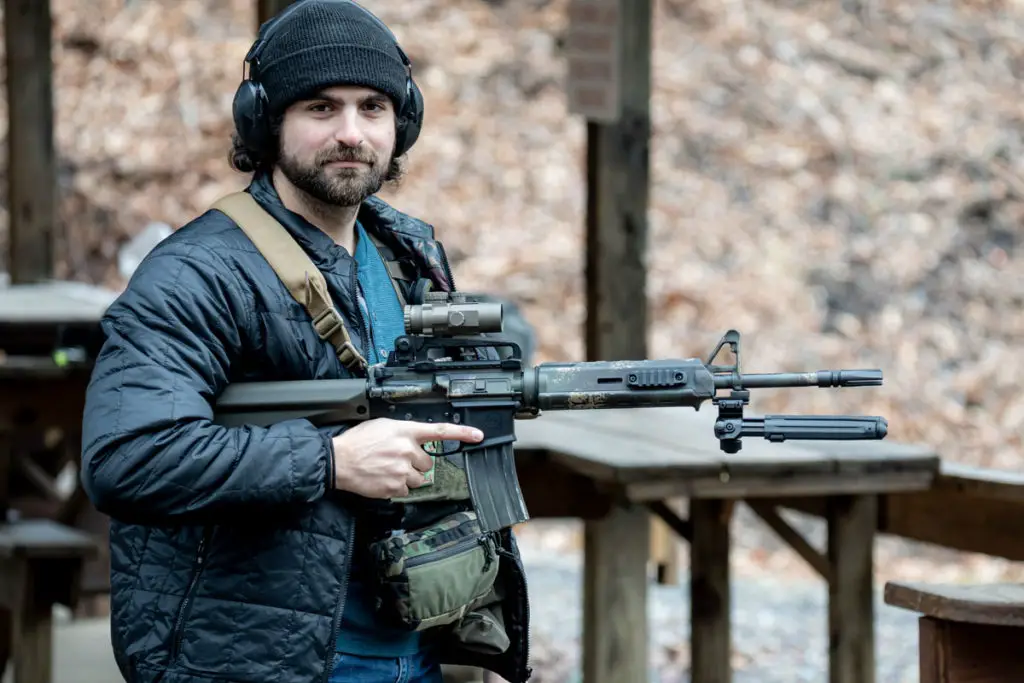
There are pros and cons to any option you choose when it comes to optics. Unless they create an optic that can transform itself into something else on the spot, this is something we’re always gonna have to deal with and, most importantly, learn to work with.
Pros
- Very Affordable
- Rugged
- Versatile Reticle
- Good mounting options
Cons
- Fixed Magnification
- Learning curve for reticle
Check Price at:
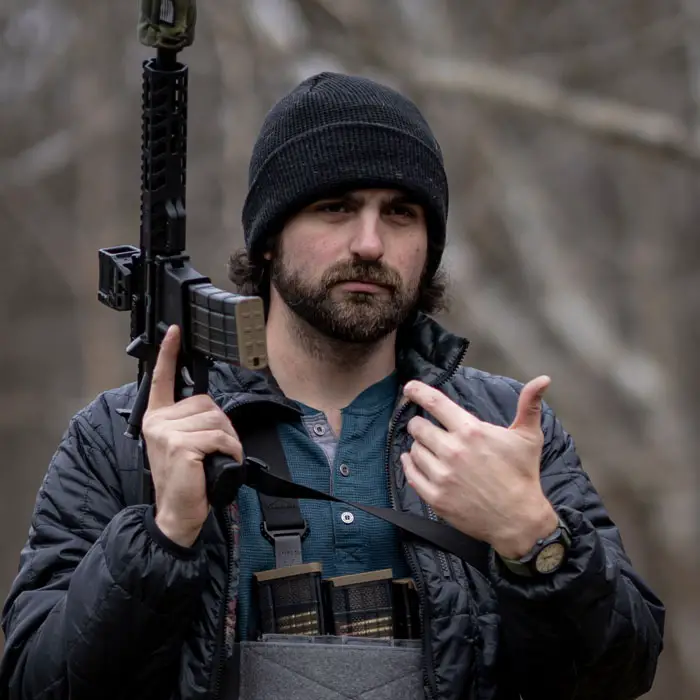
Samuel was an Infantryman for 8 years and a security contractor for another 4 years. Most of that time was spent on a sniper and designated defensive marksman team. He’s worked executive protection stateside and overseas and taught the gunfighter courses for Field Craft Survival for about 1.5 years. Samuel has been through a ton of shooting/tactics courses and was also deployed to Iraq and Afghanistan.
